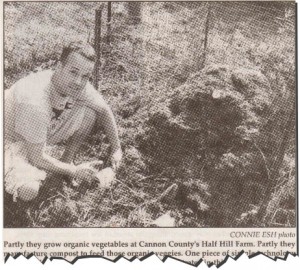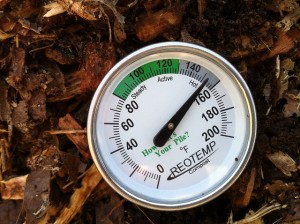 After reading our story on the front page of our local paper this week, I thought I should post some thoughts and links to supplement the section on compost making.
After reading our story on the front page of our local paper this week, I thought I should post some thoughts and links to supplement the section on compost making.
Making compost can be a tough subject for anyone to write about, but it’s one of the biggest steps I believe we can take toward reducing carbon emissions and understanding the role our own trees, plants and soil play in maintaining a natural balance.
The problem: According to a 2010 report by the EPA, the total global emissions of carbon since the Industrial Revolution are estimated at 270 F 30 Pg (Pg = petagram = 10*15 g = 1 billion ton) due to fossil fuel combustion and 136 F 55 Pg due to changes in land use and agriculture. That’s 400 metric tons of carbon. The potential of soil organic carbon sequestration through composting is roughly 1 F 0.3 Pg C/year, or 1/3 the annual increase in atmospheric CO2 per year (which is 3.3 Pg C/year).
A backyard solution: All of that simply means composting yard wastes could reduce the annual increases in carbon output over the next 20 years by 30%. That’s not through an act of Congress or demanding corporations do anything. That’s a 30% reduction made by each of us in our own backyard. Composting yard waste simply takes all the carbon that your trees and plants sucked out of the air and puts it back in the ground (sequester) where it increases the health of soil, reduces the need for chemical fertilizers, increases water conservation and reduces CO2 emissions. When we burn yard wastes or send food wastes to landfills, we release stored carbon and converted methane into the atmosphere and are part of the problem.
 How to compost: Compost consists of four things: carbon, nitrogen, air and water. Carbon is pretty much anything brown or dry like leaves, dry grass clippings, chipped wood, or shredded newspaper. Nitrogen is manure, green grass clippings, or compostable kitchen wastes. According to the National Organic Program rules for compost, a compost pile should reach 130 degrees for three consecutive days and be turned a couple times during the process. The carbon to nitrogen (C:N) ratio should be from 25:1 – 40:1. If you don’t have enough oxygen, methane (23 times worse than CO2) is produced. Too much nitrogen and nitrous oxide (296 times worse than CO2) is produced. These two gases are created in landfills when we send our compostable inputs there instead of composting them at home.
How to compost: Compost consists of four things: carbon, nitrogen, air and water. Carbon is pretty much anything brown or dry like leaves, dry grass clippings, chipped wood, or shredded newspaper. Nitrogen is manure, green grass clippings, or compostable kitchen wastes. According to the National Organic Program rules for compost, a compost pile should reach 130 degrees for three consecutive days and be turned a couple times during the process. The carbon to nitrogen (C:N) ratio should be from 25:1 – 40:1. If you don’t have enough oxygen, methane (23 times worse than CO2) is produced. Too much nitrogen and nitrous oxide (296 times worse than CO2) is produced. These two gases are created in landfills when we send our compostable inputs there instead of composting them at home.
To make a working compost pile, you need to make several alternating layers anywhere from 1-6 inches deep of either carbon or nitrogen layers. Each layer of the pile needs to be lightly watered as you make the pile. You can increase the air intake into the pile by building it in a fenced enclosure that exposes the sides, or place PVC pipe with holes in it on the ground before building the pile to allow air to circulate into the pile. After a couple days, you should see the temperature rise. When it begins to fall days or weeks later, turn the pile. After the second turning, leave the pile to cure for a month and then use the resulting rich organic compost as mulch or soil in flower beds and gardens as an alternative to commercial fertilizers.
UPDATE 05-23-14: A study released today by the Rodale Institute shows organic farm practices could overcompensate human carbon output through many required methods of sequestering carbon. Read the report here. Below is an excerpt from a Wall Street Journal post.
Citing 75 studies from peer-reviewed journals, including its own 33-year Farm Systems Trial, Rodale Institute concluded that if all cropland were converted to the regenerative model it would sequester 40% of annual CO2 emissions; changing global pastures to that model would add another 71%, effectively overcompensating for the world’s yearly carbon dioxide emissions.

I do not understand when it was written that yard waste composted can reduce yearly GHG emissions by 1/3rd when it was quoted as 0.3 pg of C where total emissions are 3.3 pg C
can you clarify